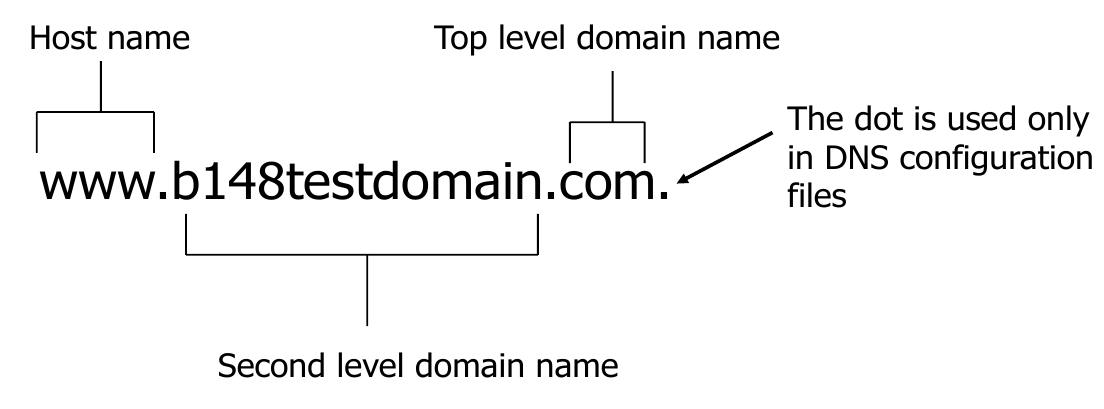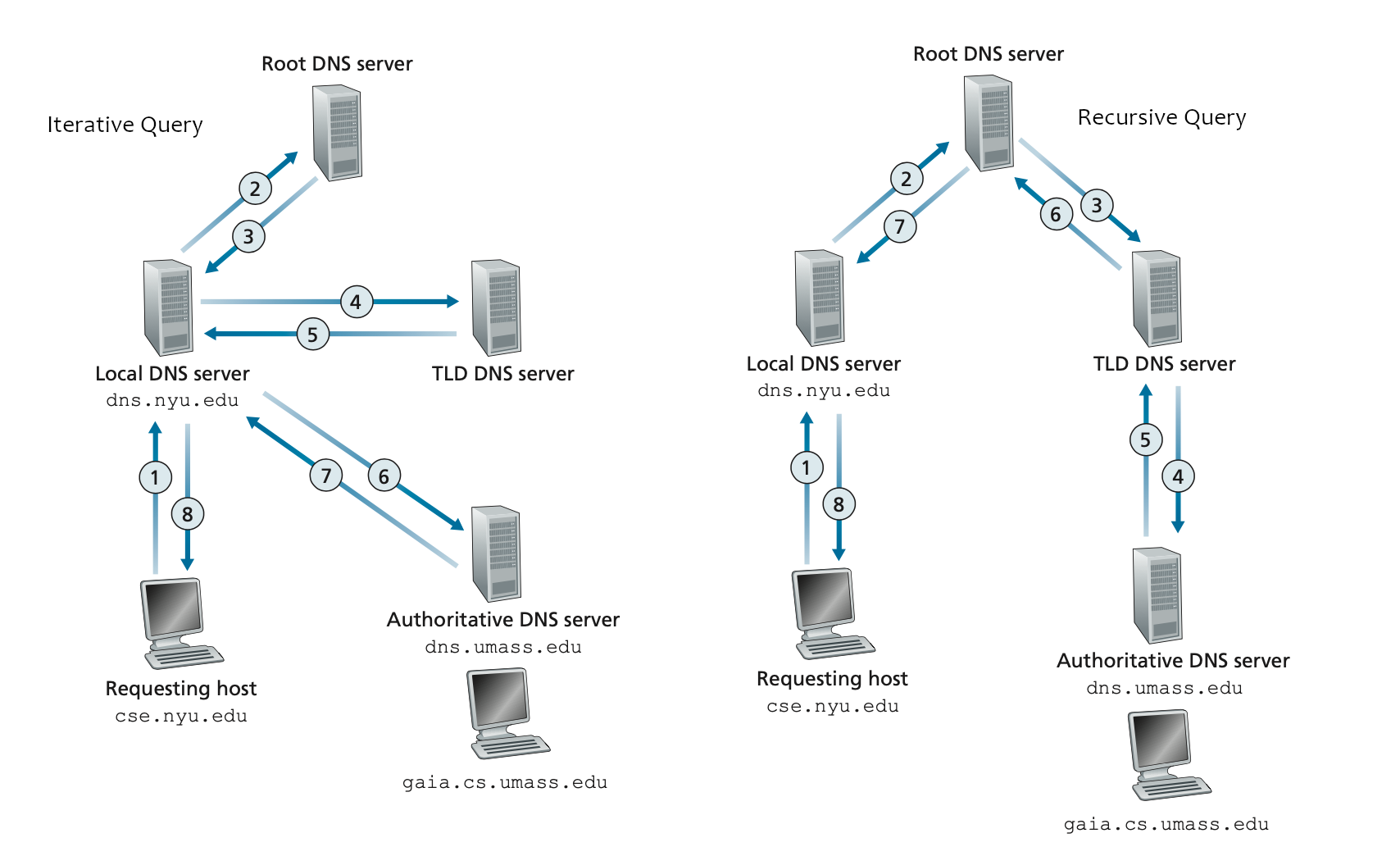3. DNS #
Hostnames #
IP addresses are good for computers but difficult for humans to remember.
Domain Name System (DNS) is an automated system used to translate names (known as hostnames) to IP addresses.
Domain Name System #
- Used to map host names to IP addresses on th eInternet
- Also called name resolution or address resolution
- A configuration file has to be manually edited whenever a host is added
- Name resolution is an essential Internet function implemented as an application-layer protocol
- Domain name information is maintained through a distributed database of hostname/IP address pairs
Distributed, Hierarchial Database #
The Internet Domain Name System is probably the largest distributed database.
There are 13 root name servers worldwide.

DNS Functionality #
- Returns the computer’s IP address given the name of a computer
- Uses distributed lookup
- Some domain names map to multiple IP addresses, e.g. multiple servers, load balancing
- Some IP addresses map to multiple domain names, e.g. aliasing of a web server
- Some domain names are virtual; maps to an IP address but the host is shared
DNS Components #
There are two main DNS components:
- Name Server (DNS Server):
- Supports name-to-address and address-to-name resolution
- Exists at all levels of hierarchy
- Name Resolver (DNS Client):
- Is linked into each application via a DLL
- Can contact DNS server to lookup names
- Used by browsers, email clients, and client utilities such as
pingandtracert
Name Server #
- Root name servers:
- Contacts authoritative name server if the name mapping is not known
- Gets mapping
- Returns mapping to local name server
- Top-level domain (TLD) servers:
- Responsible for com, org, net, edu, etc
- Also for all top-level country domains, such as, uk, fr, ca, jp
- Authoritative DNS servers:
- An organisation’s DNS servers, providing authoritative hostname to IP mappings for an organisation’s servers
- Can be maintained by the organisation or service provider
- Local DNS servers:
- Does not strictly belong to a hierarchy
- When a host makes a DNS query, the query is sent to its local DNS server
- Acts as a proxy, forwards query into hierarchy
- Configured with well-known root servers
Name Resolver #
- The resolver becomes a client by contacting a DNS server
- Each resolver is configured with the address of one or more local domain name servers
- The resolver forms a DNS request message
- The message is sent to the local DNS server
- Waits for the server to send a DNS reply message
Domain Names Syntax #
Domain names are alphanumeric segments separated by dots.
For example: www.ryanbester.com.
There can be up to 127 levels in the tree.
- Usually no more than 5 or 6 are used.
- Each level is identified by a character string of up to 63 bytes, but a FQDN can only be 255 or less
Domain names are not case sensitive.
Domain Namespaces #
- The root level domain is
. - Top level domains include com, org, net
- Second-level domains are often owned by companies and individuals
- A subdomain is a further division of a second-level domain
Every domain name actually ends with . (the root level domain), but this is usually omitted.
Top Level Domains #
- There are a limited number of TLDs
- edu, gov, com, net, org, mil, …
- Countries each have a top level domain (2 letter domain name)
- TLDs are either generic or restricted
- Generic TLDs are generally available
- Restricted TLDs can only be used by specific groups or government agencies
- DNS allows organisations to use a geographic registration
Second-level Domains #
- Second-level domains, such as
ryanbester.comhave control over naming within their domain- They can create hosts such as
www, andftp
- They can create hosts such as
- A name suich as
www.ryanbester.comis a Fully Qualified Domain Name (FQDN)
Host Names #
- The first portion of a URL is typically a host name
- This is usually different from the computer name
- Many hosts can be associated with the same server
- Many organisations assign domain names that reflect the service a computer provides

How DNS Works #
During a standard DNS lookup:
- Application sends a request to the local DNS server
- The local server:
- If the answer is known, returns the response
- If the answer is unknown:
- Starts at root-level server
- Follows links
- Returns response
DNS uses the well-known port 53.
DNS supports two paradigms of queries:
- Iterative:
- Each name server responds directly to the client with either the final answer or the IP address of another name server that should know the answer
- It is up to the client to query the next name server
- Recursive:
- The local name server determines the answer by iteratively or recursively querying other name servers
Most requests are answered via a combination of both recursion and iteration. The results may be cached.

Categories of DNS servers #
- Primary Server:
- Defines the hosts for the domain
- Maintains a database for the domain
- Each represents a small part of the distributed database
- It has authority for the domain
- Root name servers are authoritative for all TLDs
- Defines the hosts for the domain
- Secondary Server:
- Gets data from primary server
- Provides fault tolerance and load distribution
- Caching Server:
- Resolves host names
- Caches the result until the data expires
- Automatically installed when the DNS is installed
- No configuration necessary
- Forwarding Server:
- Caching server that has access to the Internet and forwards traffic from other caching servers
DNS Caching #
- Improves efficiency
- Quick response for repeated translations
- Other queries may reuse some parts of lookup
- Eliminates unnecessary searches
Cached data periodically times out, defined by the TTL (Time to Live) controlled by the data owner.
Zones #
A zone is a part of the domain namespace.
- For a domain as small as
ryanbester.com, the domain name represents a single zone - For large organisations, subdomainds can be divided into separately maintained zones
- Each zone typically has a separate DNS
- Host name assignments are maintained through zone files on the primary DNS server
- The secondary server retrieves this from the primary server
- Forward lookup zones map the hostname to the IP address, whereas reverse lookup zones do the opposite
DNS Records #
Common DNS records:
| DNS Record | Function |
|---|---|
| Address (A) | Associates a host name to an IP address |
| Canonical name (CNAME) | Creates an alias for a specified host |
| Internet (IN) | Identifies Internet records; precedes most DNS record entries |
| Mail Exchanger (MX) | Identifies a server used for processing and delivering email for the domain |
| Name Server (NS) | Identifies DNS servers for the DNS domain |
| Pointer (PTR) | Performs reverse DNS lookups. Resolves an IP address to a host name |
| Start of Authority (SOA) | Identifies the DNS server with the most current information for the DNS domain |
The A Record #
- Maps a domain name to an IP address
- DNS classifies bindings as type A
- Contains an IP address
The CNAME Record #
- Similar to a symbolic link in a file system, it contains an alias for another DNS entry
- Allows an organisation to change the computer used for a particular service without changing the names or addresses
- Also allows an organisation to associate multiple aliases with a single computer
Reverse Lookup and IN-ADDR.ARPA #
The in-addr.arpa domain is used for reverse DNS lookups.
If host.company.com maps to the IP address A.B.C.D, then D.C.B.A.in-addr.arpa maps to host.company.com
DNS Tools #
ping displays name resolution even if the computer cannot be contacted.
nslookup displays information from the DNS server.
dig available on Linux.